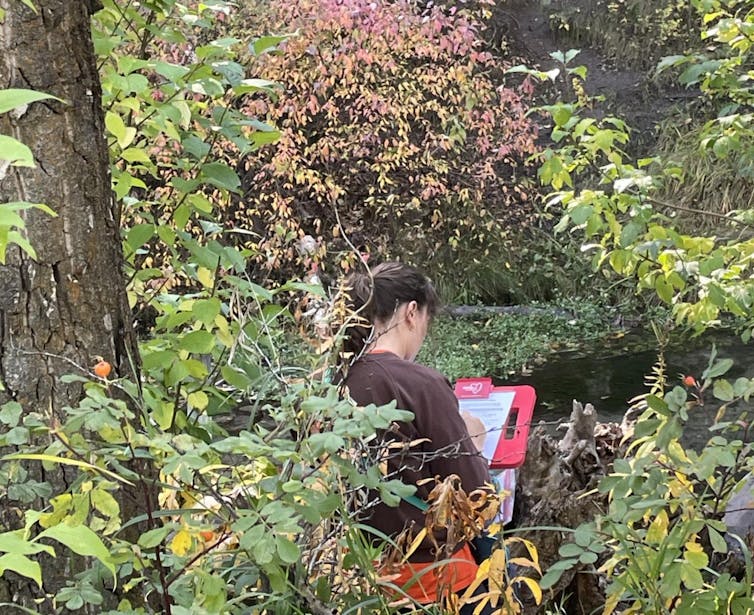Five years ago, I began a research project into emotional labour, compassion fatigue and burnout in Alberta’s educational workers.
The results from the earliest study suggested a wide scope of emotional and mental distress among teachers, educational assistants, school leaders and support staff.
This distress has been documented globally and across Canada, suggesting educator mental and emotional well-being continues to decline and interventions are needed.
Read more:
Commit to a ‘wellness streak’ to help manage work stressors
How educators manage burnout
Recently, my research team analyzed the specific interventions that our 4,000 survey respondents used to manage their symptoms of compassion fatigue and burnout. Educational worker respondents were recruited online through Alberta Teachers’ Association and internal newsletters and social media. Responses were collected across three periods (2020, 2021 and 2023). We defined intervention as a practice or strategy used to address distress or suffering.
Overwhelmingly, our respondents indicated that they used self-directed or individual interventions to deal with workplace distress such as going to a gym, walking alone, talking to friends and spouses or pursuing hobbies.
While individual interventions are one part of dealing with distress, a single person cannot self-care themselves out of the effects of a toxic workplace or organizational culture.
Workplace ‘canaries’
In their recent book, The Burnout Challenge: Managing People’s Relationships with their Jobs, workplace burnout experts and emeriti professors of psychology Christina Maslach and Michael P. Leiter used the canary in the coal mine metaphor to illustrate this point.
Similar to how miners used canaries to indicate the presence of toxic gas in the mine, the large number of absences of adults from their workplaces suggests a toxic environment. But, here’s the catch: you can rescue the canary by bringing it to fresh air, but if you put that canary back into the toxic mine, it will become sick again.
So, while individual interventions can help temporarily relieve workplace stress, the workplace itself also needs to address the root problems.
Organizational supports
In our survey, we asked participants to share strategies they use to support workplace well-being. Over 40 per cent of respondents added “improving work and classroom conditions” when asked if there was anything else they wished to tell researchers about their experiences with compassion fatigue, emotional labour or burnout.
In addition to prioritizing adequate resourcing for schools, there are clear opportunities for educational systems to integrate organizational and school-based interventions for employees, such as providing professional development opportunities or micro-programs that target and relieve workplace stressors.
Such organizational resources were the least-mentioned forms of support our survey participants currently use, but improving school and system culture could have the greatest impact on employee attraction and retention.
Get outside!
A opportunity for building well-being appeared as a new trend in the most recent analysis of our data. Over the three data collection points, more respondents wrote “getting outside” as an “other” form of intervention they were using to feel better.
This insight led me, with collaborators Nadeen Halls, a teacher consultant, and Patrick Hanlon, from the Werklund School of Education Academic Support Offices, to develop a pilot a “Walk and Learn” professional learning workshop for burned out educators. We mixed two interventions, environmental and organizational, to create a walk for local teachers so they could learn about compassion fatigue and burnout while going for a walk on trails outside Calgary in Treaty 7 territory, also home to Métis Regions 5 & 6.

(Astrid Kendrick)
As a part of the walk, we carefully selected sit-spots along the trail for reflective journaling on workplace well-being. This combined experience of physical activity and quiet reflection appeared to have a positive effect on the participants. In our post-walk feedback, 100 per cent of participants expressed appreciation for this type of professional learning. At our most recent walk in October, we had two returning participants — high praise from teachers who do not like to take the same session twice!
Partnership with local teacher association
The design of the walks has been critical. We are flexible about the trail we select, making changes to suit the abilities of all our walkers. We arranged the walks through a local chapter of the Alberta Teachers’ Association and also some school staff teams so that the walks were scheduled during the regular school day rather than during the evening or on weekends. I also secured some funding to purchase items such as mittens, toques, tissues, and bleacher-style cushions to ensure the overall comfort of the walkers.
After listening and reflecting on compassion fatigue and burnout, participants would walk and discuss the impact of these psychological hazards with their peers and colleagues. They shared their strategies to support their own and their students’ well-being.
Read more:
Heartbreak becomes burnout for teachers when work is turbulent
Maybe of the highest importance, participants have noted that the walks have helped them realize they are not alone in their suffering. These conversations between walkers created social support, a starting point for improving workplace culture.
The popularity of the walks led us to design a podcast learning series so others could enjoy the benefits of movement and learning. The HEARTcare Podcast and Learn series aims both to teach about important concepts related to workplace well-being while prompting listeners to be physically active and mentally engaged.
Unprompted feedback from podcast listeners has been positive. Our next step is to investigate the podcasts’ usefulness as a professional learning tool and strategy for stress relief.
Taking one walk or listening to one podcast is not the magic wand or cure-all that will save education. But evidence suggests that higher daily step counts have positive mental health benefitsand connecting with other people through activity can improve physical well-being.
So, don’t be afraid to walk into stress in this year — and be sure to bring a friend or colleague. It might be the only steps you need to take to feel better.
